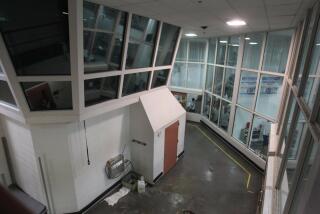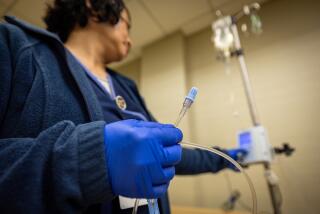Doctors Weigh Fate of Man Lying in Coma
Disconnecting life-support systems from a brain-dead, comatose patient has become such an accepted procedure that a manual on the bookshelves of hospitals throughout the state devotes four pages to protocol governing the process.
Itâs when a comatose patient falls into the âgray areasâ--when a severely damaged brain persistently gives off minimal signs of life, for example--that controversy arises over pulling the plug, hospital officials and a neurologist said Friday.
Mark Kevin Ross, lying comatose in Pacifica Community Hospital in Huntington Beach, is critically ill, but doctors have not declared him brain dead. Ross, 23, lapsed into a coma a week ago in the Huntington Beach City Jail shortly after his arrest on outstanding traffic warrants.
âAll his organ systems have been losing their functions. You can never tell what is going to happen to him. Heâs getting worse on a daily basis,â said a physician close to the case who asked not to be identified. But while Rossâ condition is deteriorating, âwhen it comes to a decision (about brain death), he doesnât fit the criteria,â the physician said.
Philip Gustafson, Pacifica Community Hospitalâs executive director, refused to discuss the Ross case specifically but said the hospital follows the guidelines suggested in a manual produced by the California Hospital Assn. that addresses discontinuing life-supporting treatment to brain-dead patients. The 504-page manual also addresses other consent issues pertaining to medical treatment.
Before disconnecting life-support systems, the association recommends that two physicians concur, based on tests, that it is unlikely that there will be âany meaningful recovery of cognitive brain function,â Gustafson said. The physicians then should meet with the family to decide whether the life-support systems should be removed, he said.
Regarding the Ross case, Gustafson said, âat this point weâre not close to any type of decision.â
Robert Ross, the comatose manâs father, said Friday the family will pull the plug only on the advice of doctors. âThereâs no hope,â Ross said. âMarkâs condition is not good. Heâs just got a couple of vital signs. . . . Iâll do whatever the doctors tell me to do.â
Dr. Stanley van den Noort, a UC Irvine professor of neurology who is not connected with the Ross case, said that to assess whether a patient is brain dead, neurologists perform a standard battery of tests to look for reflexes and other physical reactions that indicate brain activity.
Water in Ears
For example, he said, the physicians usually check the pupils of the eyes for reaction to light and put a little cold water in the ears, a procedure that should result in a jerking of the eyes. No reaction indicates âthat even the lowest parts of the brain arenât working,â he said. Sometimes more sophisticated tests are performed, such as injecting radioactive isotopes into the patient to monitor whether there is circulation to the brain, he said.
Neurologists also routinely perform an electroencephalogram, or EEG, to pick up traces of brain activity, van den Noort said. If the brain is dead, âit should be flat,â he said, âand then it should be repeated 24 hours later.â If it is still flat during the second test, and there is no âbehavior in response to stimulation,â the criteria for brain death have been met, he said.
However, if the flat EEG has been produced by a drug overdose, the physician should be more cautious because âa drug overdose will sometimes give a flat EEG for more than 24 hours, then a later test will show some activity,â he said.
The decision to disconnect life-support systems for brain-dead patients rests with the family but has been an accepted procedure for five to 10 years, van den Noort said. The more controversial situations, he said, involve patients in âa hopeless situation,â in deep comas but nonetheless showing a few signs of brain activity.
âThereâs no chance of recovery. The doctors know that, and the family knows that,â he said. But without brain death, âas far as Iâm concerned, (disconnecting life-support treatment) requires a court order,â van den Noort said.
Ted Fourkas, director of public information for the California Hospital Assn., said a 1983 state Court of Appeal decision in the case of Drs. Neil L. Barber and Robert J. Nejdl âhas clarified a lot of issuesâ regarding when doctors and hospitals can withhold treatment. The doctors had been charged with murder and conspiracy after they disconnected the life-support systems of a severely brain-damaged patient.
The courtâs decision--which dismissed the charges against the physicians--established that the benefit of continued treatment should be evaluated in terms of how long it will continue life and of whether there is a possibility that the patient will recover awareness.
Advisory Role Only
Fourkas said the decision also established that âhospitals donât pull the plug, nor in general do the physicians. Theyâre to be the advisers.â The decision, he said, must rest with the patient--if the patient is conscious enough to be consulted--or with the family, if the patient is physically unable to decide.
âBut in the case of brain-dead patients, or patients who will never regain consciousness, weâve pretty well laid out the picture,â Fourkas said. âThere will always be cases in the gray areas, and in those cases you can still go back and get a court order.â
A good example, he said, was the case of Elizabeth Bouvia. The quadriplegic woman won a court order earlier this year allowing her to refuse force-feeding or any other unwanted medical treatment. Bouvia later sued again when doctors attempted to cut back her dependence on morphine. She now is at Los Angeles County-USC Medical Center, where she has been eating voluntarily and is being administered morphine.
The âright-to-dieâ issue gained national publicity a decade ago with the case of Karen Ann Quinlan, who lapsed into a deep coma in 1975 and was kept alive on a respirator. Her parents sought to remove her from the equipment, and in 1976 won a landmark decision when the New Jersey Supreme Court ruled that the respirator could be disconnected. Despite her doctorâs predictions, Quinlan remained alive in a deep coma for nine years.
More to Read
Sign up for Essential California
The most important California stories and recommendations in your inbox every morning.
You may occasionally receive promotional content from the Los Angeles Times.










